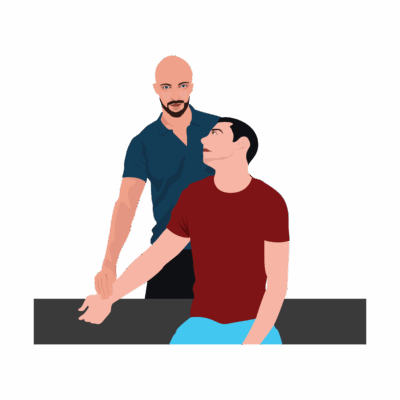Adson’s Test
Adson’s Test is a clinical orthopedic assessment used to evaluate for thoracic outlet syndrome (TOS), specifically by detecting compression of the neurovascular structures (mainly the subclavian artery and brachial plexus) as they pass through the interscalene triangle—between the anterior and middle scalene muscles. This test is particularly relevant for identifying vascular or neurogenic TOS due to posture, muscle tension, or anatomical variations.
How the Test is Performed
-
Client position: Sitting or standing, arms relaxed at sides.
-
The therapist palpates the radial pulse on the affected side.
-
The client is instructed to extend the neck and rotate the head toward the tested side (chin up and toward the same shoulder).
-
The client then takes a deep breath and holds it for several seconds while the therapist maintains pulse palpation.
-
In some variations, the arm is also abducted, extended, and externally rotated slightly.
-
Positive test: Diminished, weak, or absent radial pulse and/or reproduction of neurological symptoms (numbness, tingling, pain) in the arm or hand.
Clinical Significance
-
A positive Adson’s Test suggests neurovascular compression in the thoracic outlet, most commonly due to tight or hypertrophied scalene muscles, cervical rib, or fibrous bands.
-
Sensitivity and specificity values for this test range between 74–94% and 74–100% in various studies, but false positives are possible—interpret in the context of history and other tests.
-
A positive test may be associated with “scalenus anticus syndrome” (a type of TOS caused by the scalene muscles).
Assessment
-
Use Adson’s Test for clients with:
-
Neck, shoulder, or upper extremity pain/paresthesia
-
Symptoms of numbness, tingling, heaviness, weakness in the arm and hand
-
Suspected TOS due to poor posture, scalene hypertrophy, repetitive overhead activity, or trauma
-
-
Document pulse changes, reproduction of symptoms, and the side tested.
Treatment
-
If positive:
-
Avoid deep, compressive work over the scalenes or first rib, and avoid positions that increase neurovascular tension.
-
Focus on gentle soft tissue work and myofascial release to the anterior/middle scalenes, subclavius, and pectoralis minor as tolerated.
-
Educate clients on postural correction and ergonomic modifications to reduce TOS recurrence.
-
Prioritize restoring mobility and balance of the rib cage, thoracic spine, and upper shoulder complex.
-
Safety and Referral
-
Refer for further medical or physiotherapy evaluation if symptoms are severe, progressive, involve vascular changes, or do not improve with conservative care.
-
Clients with acute vascular TOS (signs of compromised blood flow) require urgent multidisciplinary assessment.

